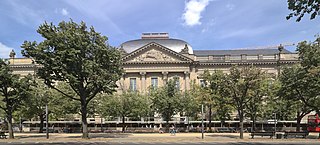
The Berlin State Library is a universal library in Berlin, Germany and a property of the Prussian Cultural Heritage Foundation.
Konrad Theodor Preuss was a German ethnologist. He was chairman of the Lithuanian Literary Society (1890–98).

Francísco Ximénez was a Dominican priest who is known for his conservation of an indigenous Maya narrative known today as the Popol Vuh. John Woodruff has noted that there remains very few biographical data about Ximénez. Aside from the year of his birth, baptismal records do not agree on the actual date of his birth, and the year of his death is less certain, either in late 1729 or early 1730. He enrolled in a seminary in Spain and arrived in the New World in 1688, where he completed his novitiate.
Since the 18th century Berlin has been an influential musical center in Germany and Europe. First as an important trading city in the Hanseatic League, then as the capital of the electorate of Brandenburg and the Prussian Kingdom, later on as one of the biggest cities in Germany it fostered an influential music culture that remains vital until today. Berlin can be regarded as the breeding ground for the powerful choir movement that played such an important role in the broad socialization of music in Germany during the 19th century.
The Prussian Cultural Heritage Foundation is a German federal government body that oversees 27 museums and cultural organizations in and around Berlin, Germany. Its purview includes all of Berlin's State Museums, the Berlin State Library, the Prussian Privy State Archives and a variety of institutes and research centers. As such, it is one of the largest cultural organizations in the world, and also the largest cultural employer in Germany with around 2,000 staff as of 2020. More than four million people visited its museums in 2019.

The Staatliche Museen zu Berlin are a group of institutions in Berlin, Germany, comprising seventeen museums in five clusters; several research institutes; libraries; and supporting facilities. They are overseen by the Prussian Cultural Heritage Foundation and funded by the German federal government in collaboration with Germany's federal states. The central complex on Museum Island was added to the UNESCO list of World Heritage Sites in 1999. By 2007, the Staatliche Museen zu Berlin had grown into the largest complex of museums in Europe. The museum was originally founded by King Friedrich Wilhelm III of Prussia in 1823 as the Königliche Museen.

The Kulturforum is a collection of cultural buildings in Berlin. It was built up in the 1950s and 1960s at the edge of West Berlin, south of the Tiergarten, after most of the once unified city's cultural assets had been lost behind the Berlin Wall. The Kulturforum is characterized by its innovative modernist architecture; several buildings are distinguished by the organic designs of Hans Scharoun, and the Neue Nationalgalerie was designed by Mies van der Rohe. Today, the Kulturforum lies immediately to the west of the redeveloped commercial node of Potsdamer Platz.
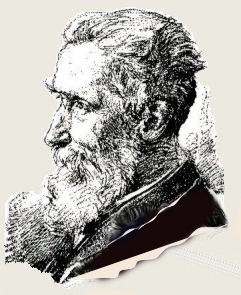
Eduard Georg Seler was a prominent German anthropologist, ethnohistorian, linguist, epigrapher, academic and Americanist scholar, who made extensive contributions in these fields towards the study of pre-Columbian era cultures in the Americas.

Karl Oenike (1862–1924) was a German landscape painter, who participated in various scientific expeditions in South America during the years 1887-1891 as painter and photographer. He wrote detailed diaries and made drawings, sketches, watercolors, oil paintings and photos during these expeditions, which give a valuable perspective of remote regions and populations, and of the difficulties encountered by German explorers in the 1880s. Few artists in the exotic art genre have depicted better the “magic of the forest” in his paintings.

The Kunstgewerbemuseum, or Museum of Decorative Arts, is an internationally important museum of the decorative arts in Berlin, Germany, part of the Staatliche Museen zu Berlin. The collection is split between the Kunstgewerbemuseum building at the Kulturforum (52°30′35″N13°22′03″E) and Köpenick Palace (52°26′38″N13°34′22″E).
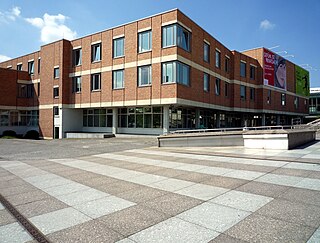
The Kupferstichkabinett, or Museum of Prints and Drawings, is a prints museum in Berlin, Germany. It is part of the Berlin State Museums, and is located in the Kulturforum on Potsdamer Platz. It is the largest museum of graphic art in Germany, with more than 500,000 prints and around 110,000 individual works on paper.

Eberhard von Stohrer was a career German diplomat who served during World War I and World War II. The son of an Army General from Württemberg, he studied at Leipzig University, receiving a Doctor of Law degree. He also studied at the University of Strasbourg and the School of Political Sciences in Paris.

Eckhard Unger was a German assyriologist.
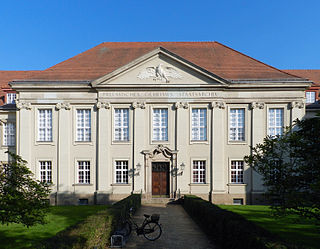
The Secret State Archives Prussian Cultural Heritage Foundation is an agency of the Prussian Cultural Heritage Foundation headquartered in Berlin, Germany. A Federal statutory body, it is one of the largest repositories of primary source documents in Germany and spans the history of Prussia, Brandenburg, the House of Hohenzollern and the Prussian Army. Insofar as the agency represents over 400 years of archival work of the former states of Brandenburg-Prussia, including their main roots in the Teutonic Knights, the Archives can be said to cover "nine centuries of European history between Königsberg and Cleves."
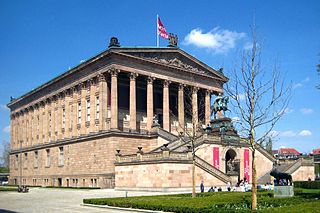
The National Gallery in Berlin, Germany, is a museum for art of the 19th, 20th and 21st centuries. It is part of the Berlin State Museums. From the Alte Nationalgalerie, which was built for it and opened in 1876, its exhibition space has expanded to include five other locations. The museums are part of the Berlin State Museums, owned by the Prussian Cultural Heritage Foundation.
Edgar Wisniewski was a German architect. He was a student and later business partner of Hans Scharoun.
Friedrich Wilhelm Birnstiel was an 18th-century German music publisher known for publishing two volumes of four-part chorales by Johann Sebastian Bach in the 1760s.
Conny Restle is a German musicologist, Museum director and lecturer at the Berlin University of the Arts.

Otto Kümmel was a German art historian, academic teacher, founder and director of the Museum of Asian Art in Berlin and general director of the Berlin State Museums.













